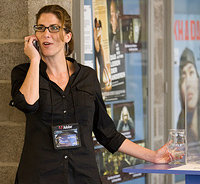It's not uncommon to hear web developers discussing colors. How do I choose them? How do I get them to harmonize? How do I know what the trends are? Or even, when in the world did everyone start using orange?
Since color has been an integral part of several fields I've worked in over the years, I've studied it in depth. I commonly use color psychology when choosing color palettes for client sites. I know before I create the client's palette what my desired outcome is. Do I want to jazz the surfer up or calm them down. Do I want them to take action, or do I want them to relax and read? Do I want the site to be punchy (complimentary color palette) or soothing (monochromatic color palette)? I wrote an article at CMX last year on The Science of Color which discusses the meanings of colors and how to select and blend them — or you can Google for color psychology/theory info yourself.
Psychology is always a factor in my color decisions. But what other factors exist? A big one is trend. You may think that trends just appear out of the collective social consciousness of our minds, catch on like wildfire and spread. You're only about a quarter right with that theory. The social consiousness is tapped into. So are economic trends, the political climate and maybe a few mind altering substances. But it's a group of about 1,500 color designers, at Color Marketing Group, who make these predictions/decisions. “Our members are highly qualified Color Designers who interpret, create, forecast and select colors in order to enhance the function, salability and/or quality of a product.” In other words, if the colors aren't predicted two years ahead, how will the dye makers know what color to produce for the fabric suppliers who will be supplying the clothing manufacturers whose designers will be creating the advertising that makes you believe you will not live if you don't have that perfect pink shirt?
If you've been to the mall, or even out on the streets, you know they did well marketing pink this year. It's everywhere. That may be proof enough that the CMG does use economics and social mood in their predictions. After all, psychological testing has shown that a certain shade of coral-pink may be calming and create lower violence in prisons. Pink is regarded, in psychiatric literature, as the color of delusion and denial — rose-colored glasses if you will. Some believe its rise may foretell a harsh stock market reaction. So does this mean, it's time for us as web developers, to add some form of it to our next soothing, upbeat web site? Is color in web design like home decorating — always a couple years behind the clothing trends?
There's another way to stay on top of the trends as they're happening. Twice yearly, Pantone creates and distributes their Pantone View Colour Planner, a binder featuring half a dozen or more palettes with names like Twilight Shadow, Black Sapphire, Briar or Thistle Bloom. Regularly priced at $750, I found it at Studica for the bargain price of $589.95. If that is as out of your budget as it is mine, you can at least read the descriptions of the colors, released in June at Graphic Design USA.
According to the Graphic Design USA report, “OPTIMISM DRIVES 2005 CONSUMER COLOR PALETTE – The emotional response to color humanizes hues for 2005, according to the color designers of the Color Marketing Group. While consumers desire comfort, stability and security, they optimistically yearn for bright and fresh signs of a better world to come. CMG's color professionals expect next year's colors to convey a respectfully serious nature yet touch the soul. They chose a 2005 Consumer Color Directions Forecast that includes many light-infused, optimistic colors.“
According to the CMGs report, consumers are yearning to return to their roots and traditional materials such as metal, leather wood and sand will be applied to the latest technological products (it's obvious that Apple must be a member of the CMG). The visual communication category states that “edges will be blurred, luster sculpts patterns, tone on tone creates textures … resulting in a discreet luxury.” People desire serenity and security and color will allow for individual expression and cultural diversity. Okay, sure. So how do we translate this to web design? When I figure out what it is, I'm going to start using Black Sapphire everywhere. “Black Sapphire – Tradition with a youthful twist, safety with an attitude, this petrol-tinged jewel reinvents corporate blue.” Don't know about you, but I'm really, really tired of corporate blue.
